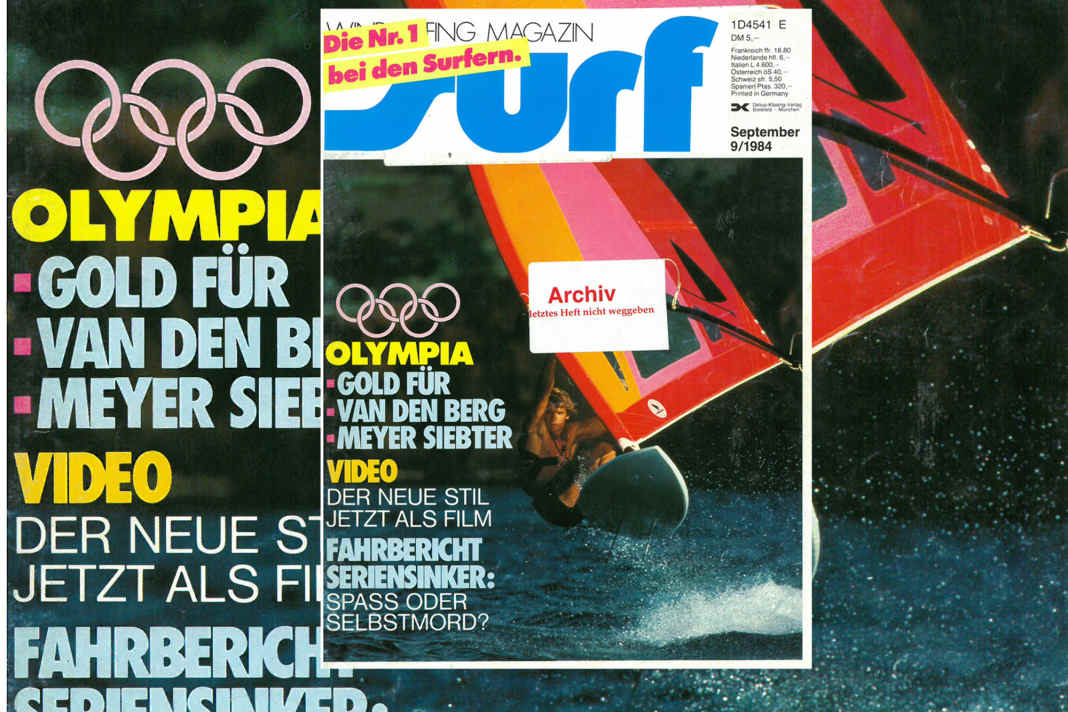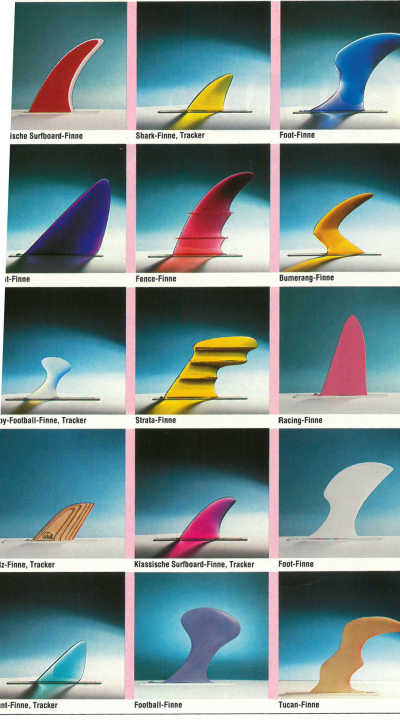





There was something historic to read in the September 1984 issue: Windsurfers took part in the Olympic Games for the first time! Sinkers were tested alongside the windglider world of the Olympians and an overview of the fin shapes commonly used at the time was shown - highly adventurous from today's perspective. There was plenty of space for the "new style", a riding technique course with duck jibe and co. surf even produced an elaborate film with Pete Cabrinha and tester Kutte Prießner back then - absolute gold!
Historic Olympia
Only 17 years after the invention of windsurfing, the sport celebrated its Olympic premiere in Los Angeles in 1984. surf was on site with editor-in-chief Uli Stanciu and editor Angelika Schäfer and reported - and that was necessary: "Television and daily newspapers reported extremely poorly, the courses were so far away from land that you couldn't see anything at all from the beach, and there were no spectator boats!" There was also dissatisfaction among the riders - the area off Long Beach was supposed to offer strong winds, but only had a tired breeze. Most of them told surf that they now wanted to switch to fun boards and become professionals.
Another big issue at the time: the pumping ban. Frenchman Gildas Guillerot was disqualified for allegedly pulling the fork "14 times within 15 seconds" and Dirk Meyer from Berlin slipped into first place in the first race. In the end, he finished in seventh place. The Olympic champion was Stephen van den Berg from the Netherlands ahead of Scott Steele (USA) and Bruce Kendall from New Zealand. The latter had trained at home on a windsurfer instead of the Olympic windglider board - because he was unable to get hold of one of the two (!) windglider boards available in New Zealand. "Pumper" Guillerot still managed fourth place and walked around the paddock smoking a chain - even in the picture in the magazine he has a cigarette in his mouth...
Finn salad
The eighties were also the decade of wildly proliferating Finnish creations. surf gave an overview in the September issue and tried to point out the differences. Because: "With speed came the spin-out, which hung like a sword of Damocles over every exhilarating speed adventure." From today's perspective, foot or football finals in particular seem strange. The explanation at the time: "Due to the offset between the base and the tip of the fin, these shapes give the board more guidance with increasing speed," shaper Helmut Kirner explained to surf readers at the time. "Also, the forward curved noses at the end of foot and football fins are designed to prevent air bubbles from travelling to the tip of the fin."
However, other fin shapes from back then are quite common today, and multifin boards have become established anyway. The "stunt" fins, for example, are very similar to steep wave fins or today's freestyle fins. Other creations, however, have completely disappeared, such as the boomerang or tucan fin. I wonder what the Saxon police would say about such sabre-like constructions today?

The new style
With the funboards came new manoeuvres and a new riding style. surf not only dedicates a riding technique series with Pete Cabrinha to this development, but also an elaborately produced film. In it: Kutte Prießner as a surf nostalgic with a giant board and wooden boom, which he transports in a rickety duck. Shooting star Pete Cabrinha is completely different. He arrives in a chic Quattro from sponsor Audi and naturally gets the blonde beauty in the passenger seat. Later, the Audi engages in a speed duel with a windsurfer at an incredible 50 km/h. But: "Despite beautiful or funny pictures, it is always clear that this video is an instructional film!" points out the surf author. Kutte gets Pete to teach him the beach start, and the blonde in the passenger seat turns out to be surf instructor Doris Straub, who shows that "funboarding is not the domain of men, girls and women can also keep up here".
If this Making Of in the magazine whetted your appetite for the film, you could buy the 1984 VHS cassette "Funboard Windsurfing - The New Style" for a mere 148 marks. We went deep into the archives and dug out the masterpiece and made it available for you on the surf TV channel on YouTube. Have fun!
Test of the series sinkers
"Fun or suicide?" says the title, while the introduction to the test talks about "suicide boards" and "widow makers". Nevertheless, some surf editors bravely threw themselves into the surf on Fehmarn (after a journey with obstacles) to test sinkers from the series. For many brands, these were more of a marketing stunt than a product for the masses - those who could ride one usually had a custom with them. Four boards are included in the test: The "Hagan Jibe" (280 cm, 86 litres), "Aska Cobra" (267 cm, 102 litres), "Surfpartner Wet" (282 cm, 89 litres) and "Ten Cate Shot" (280 cm, 96 litres).
One finding of the test: "Sinkers are not generally dangerous. They are only dangerous for those who overestimate their own riding ability and underestimate the conditions!" warn the editors. Speaking of conditions: The authors never tire of emphasising that sinkers only work from a breathtaking wind force of four. But then things really take off: "Sinker riding is absolutely insane, the hottest thing you can experience on the water!"
And what else?
- In the summer of 1984, TÜV offered a safety inspection of equipment throughout Germany. The result: 80% of the 3,200 surfers who took part were riding safe equipment, but: "Extreme board buyers on inland lakes in particular greatly overestimate their own riding ability."
- In southern Germany, a hailstorm is "devastating" "large areas of land" - and windsurfers are to blame, a newspaper claims. "Because they misused the storm warnings on the radio as an invitation to surf", the Bavarian radio station Bayerischer Rundfunk stopped broadcasting warnings. surf clarifies: Severe weather and storm warnings are "two pairs of rain boots", the hail had also surprised the meteorologists at the time.
- For surf, a scientist investigated what a safe foot loop should look like. The results can be seen in a highly reputable graphic - including the pain threshold!

- A big thing in advertising at the time: drysuits. The "Ronny Rollover" is one of "three drysuits in which you look three times as good!"
- Full spots and the associated problems were already an issue in 1984. Even back then there was the threat of spot closures and conservationists railed against the "scarecrows" in restricted zones. surf argues that windsurfers themselves suffer from much worse environmental sins and have to pay for falling into "completely contaminated Ruhr lakes with weeks of diarrhoea and skin rashes". The issue of a limited number of surfing licences is also under discussion. surf announced a draft model agreement for 1985.
- The World Cup at Diamond Head suffers from weak winds and a spontaneous rule change: only complete manoeuvres count in wave riding - so almost all riders are overcautious. During the final course race, dark shadows suddenly appear under the regatta field - sharks? No, a pack of dolphins accompanies the riders along the entire course!

